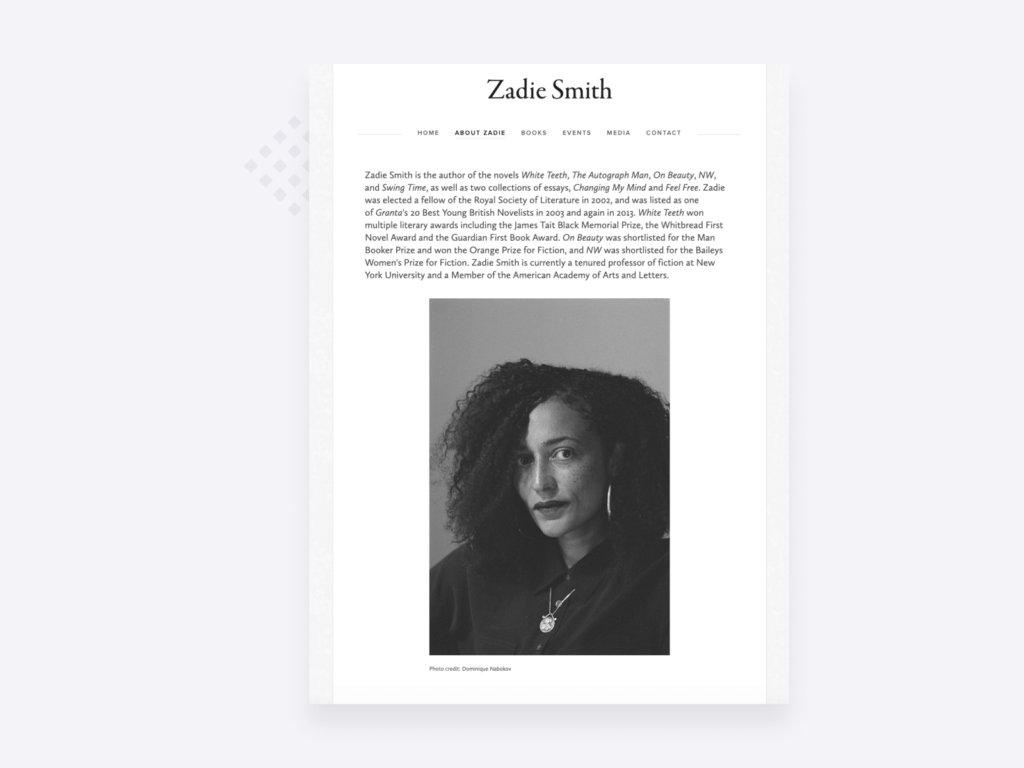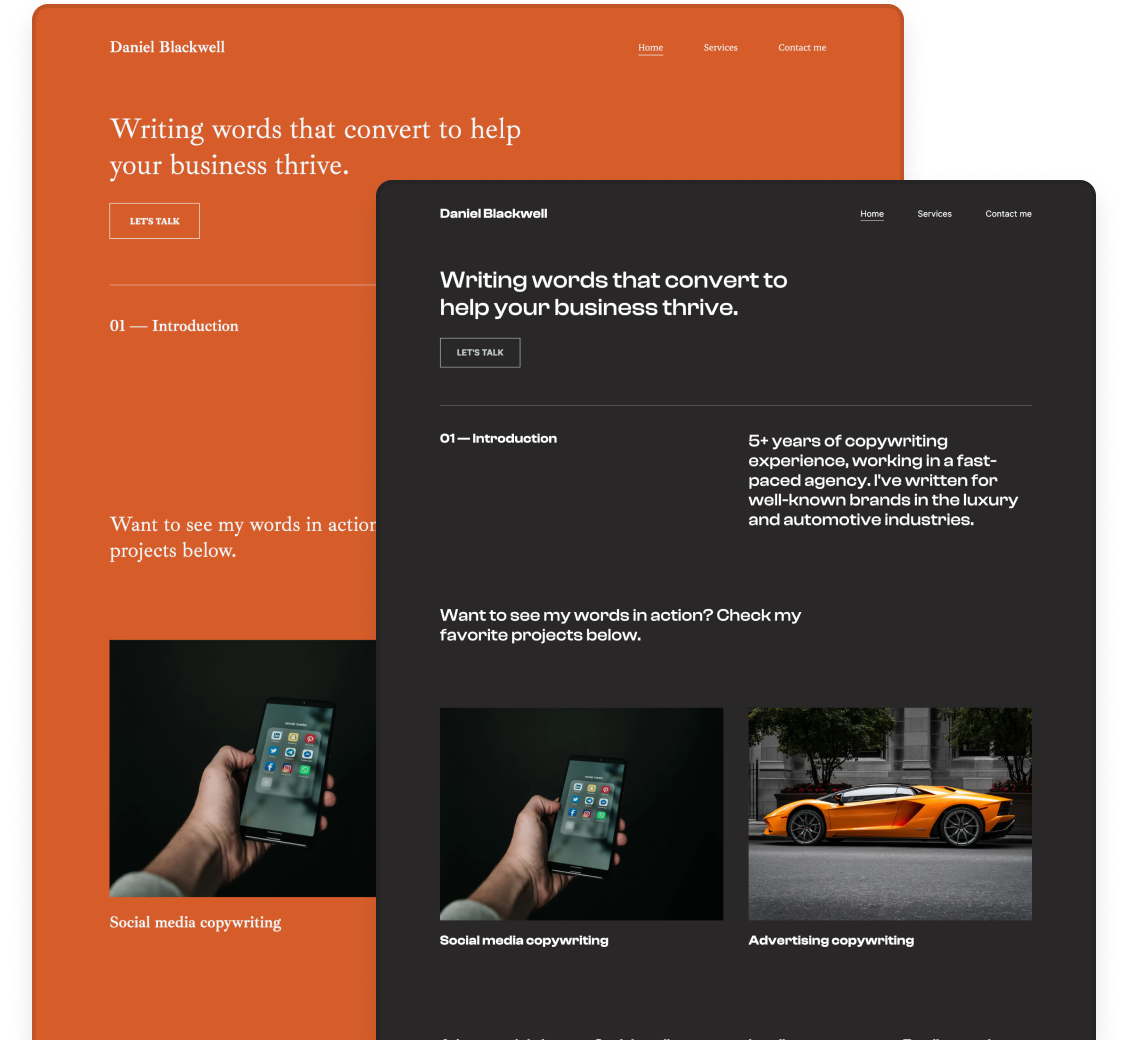How to Build A Writing Portfolio Online & What to Include in It
You’re a professional writer. Or aiming to be one. If we met and you wanted to prove it, what would you do? Scribbling a witty line on a napkin wouldn’t be too impressive, would it?
Your best bet is handing over a link to your portfolio: a website that houses your best work and all the information someone would need to know about you.
If we asked for it right now, would you be able to send it over?
If the answer is no, either because you don’t have one or because it’s just not good enough, don’t worry.
This article is here to help. We’ll go over everything you need to know to choose the perfect writing samples and build a stunning writing portfolio. We will also show you a tool that will let you build a website in half the time.
What to include in your writing portfolio?
We always say: just get started! Start building your portfolio, get in the rhythm and you can always keep improving it. You don’t want to get stuck with preparing for too long.
But even if you don’t spend ages picking the samples beforehand, it’s good to know and think about what kind of writing pieces you could include when the time comes.
The kinds of writing pieces differ quite a lot based on what kind of writing you do, so in this article, we’ll separate the tips and discussion for:
- Copywriters,
- Content writers, and
- Authors and creative writers
Feel free to jump to the section most relevant to you and skip the others.

The homepage of the Andrea Emerson's website
Copywriters
If your chosen niche is the industry you usually write for, it’s best to choose at least a couple of different formats for the samples that make it into your copywriting portfolio. Let’s review what these most common formats are.
Common copywriting formats
Copywriting samples you could include in your writing portfolio can be:
- Advertisement campaign headlines and copy
- Billboards and other ATL marketing materials
- Copy for websites and landing pages
- Email marketing samples
- Facebook, Google and other digital ads
- TV commercials or radio spots
- Facebook, Instagram, Twitter and other social media posts
- Print advertisement for magazines, flyers and more
But if you’re specialized in one of these formats, let’s say email marketing, then you could turn it around and choose emails you’ve written for companies from different industries.
If you’re aiming for a position at a specific company, you should check what forms of copy they use the most. Are they active on social media, using Facebook ads all the time? Are they big on TV commercials and ads in magazines?
Try to tailor the samples and include the ones that are most suitable for your target clients or employers. One look at your portfolio and they will think “wow, they do exactly what we need!”. It’s a pretty good way to convince them you’re the perfect candidate, isn’t it?
What if you don’t have any copywriting experience?
You need work experience to get a job, but you need a job to gain experience. We’ve all been there, it’s a tricky situation. But luckily, if you’re a copywriter, there are some ways to get a few good samples in your portfolio without actually getting hired for a job.
- Use spec ads or projects from courses. If you’ve done any kind of copywriter training, there’s a chance that you had course projects to complete or had to write spec ads. Before getting a real copywriter job, feel free to use these in your portfolio.
- Simply makeup projects yourself. Who says it has to be a real assignment for it to showcase your copywriting skills? You can just make up a job and treat it as a real one. Write your own brief and work just as hard as you would do on a paying gig.
- Offer to work for charities or NGOs. When you’re just starting out, you can reach out to some local charities or NGOs you’d like to support, to see if they need any copywriting help. They often do but cannot afford to pay much for it. So they will gladly take you on board and let you use the pieces in your portfolio.
- How about friends and family? The same goes for people in your friend group or family members who own businesses. You can offer to write for them and will not only get samples but honest and constructive feedback too.
Content writers
For content writers, the content writing samples you include in your portfolio are typical long-form pieces. Think articles and blog posts. As the formats are not as diverse, here we’d like to focus on how to get samples instead of the formats to choose from.
Previous projects you’ve completed are on the top of the list of course, but there are a few other ways to add credible pieces to your portfolio. Even if you’re just starting out.
In these cases, where your piece was published can play a big role in how your portfolio is going to be perceived. If you can produce some big names (think blogs and publications) and great statistics, it will immediately establish you as a credible and professional content writer. Even if these are the only projects in your writing portfolio.
Self-publish articles on your own site
Although you’ll have to have your website set up already, publishing articles on your own is probably the easiest method. You won’t have to pitch to anyone and nobody will tell you what to write about and how.
The downside of it is that publishing a post on your own blog won’t give you the same credibility as doing it on a bigger, renowned blog. But you can compensate with statistics from Google Analytics.
If your articles have gathered a considerable amount of visitors, either from search or social shares, make sure to include the numbers. Even if it wasn’t published on a famous site, if you can prove that what you write performs well regardless, that should be enough.
Write on Medium
Another way is to write and publish your articles on Medium. It gives you a platform to work with (so no website needed) and a community that can make getting readers easier.
Not to mention that if your articles are good enough, you can even get paid for them through their Partner Program.
Another advantage is that you don’t need to pitch ideas here either - you can choose what you want to write about freely. And the downside? You won’t be able to customize the platform itself, and it will not run directly under your name, under your domain.
And even though most people are familiar with Medium, they also know that it’s just a free platform where anyone can publish. This means that publishing your article here won’t give it any additional credibility.
Try guest posting on well-known blogs
This third and last option can be the hardest to get but also worth the most.
When it comes to guest blogging, first you’ll have to find the publication you want to be featured in. That alone might take some time, as not all sites accept guest posting. It might take a few outreach emails until you find one that is both suitable for you and interested in publishing a piece you wrote.
Once you found one, you have to pitch some ideas and convince them that you have (or can produce) a piece that’s worth posting. They might ask for titles and drafts and it can take some back and forth emailing until you settle on a topic.
When writing an article, one more thing you need to pay attention to is their editorial guidelines. They vary for each blog and publication and it’s important that you follow them. It will make the process faster and easier and show them your professionalism.
The good thing about landing a piece in a well-known publication is that you can not only link to it in your portfolio but include a short author bio (with a link) in there too. This way it’s not going to be only you directing people to the article from your portfolio, but it will work the other way around too.
Authors and creative writers
The pieces you include in your writing portfolio differ the most for authors and creative writers.
Book samples

A page about the book "milk and honey" on Rupi Kaur's website
When the bulk of your work consists of books, nobody will expect to be able to read any of them in full capacity as part of your portfolio. What you can do though is create a page on your author website for each book and:
- Write a short summary of what it’s about
- Feature reviews, especially if they were published in well-known places
- Add details such as genre, number of pages, and anything else you’d normally find on a vendor’s page, and
- Link to places where visitors can buy the book
Additionally, you can feature short samples of the book. Add just a couple of pages, so people can get an idea of your writing style and the overall mood of the book.
Shorter pieces
Books are not the only pieces of writings that have a place in your creative writing portfolio. If you have any shorter pieces like poems, which are still easy to read through, feel free to include them as well.
The important thing is to always consider your objective and target audience when selecting the pieces. Is it going to be of value for them, when they evaluate you as a writer? Is it something they will enjoy reading and will actually finish? If your answer is yes, into the portfolio it goes!
5 tips for building a writing portfolio
Next, we’ll review the most important tips to make your portfolio building experience as smooth as possible.
Homepage must-haves

The homepage of Elise Dopson's website
The most important page of your writing portfolio website is your homepage. This is where everyone lands and gets their first impressions after all. There are certain elements your homepage must have if you want it to have a good conversion rate.
A short bio and a photo of yourself
When someone visits your page, they should be able to immediately tell the basics of who you are and what you do. Are you a copywriter? Freelance content writer? Technical writer? Bestselling author?
So including a short bio is the first step, when it comes to building your homepage. Ideally, you should add a picture of yourself too. We’re wired to be drawn to human faces, and seeing somebody’s picture makes it easier to build rapport and a more personal connection.
A navigation bar
Okay, this person landed on your website and found out who you are and what you do. Now they wanna go on and learn more. How do they do that?
You need to make it as easy as possible for them to find what they’re looking for. Add a navigation bar to the top or the side of your page. Also, add sections with call-to-action buttons leading to the most important pages on your homepage.
What are the pages you cannot miss from your navigation?
- Home - so they can go back easily from another page
- About me - so they can find out more about you after reading your bio
- Portfolio - so they can check out your work, and
- Contact - so they can get in touch with you
If you’re a freelance writer, you should also add your Services page to the navigation bar. Or if you’re looking for an in-house position, you can add your resume there instead.
A clear call-to-action
As visitors should be able to easily find what they’re looking for, it should also be clear for them what you want them to do next. And this is what a call-to-action or CTA is for.
Asking visitors to do multiple things on one page will only distract them. So as a best practice, you should choose one action you’d like them to take, and only feature that on your homepage. This could be asking them to:
- Check out your portfolio
- Get in touch with you
- Subscribe to your newsletter
- Download your free eBook
- Get a personalized quote or offer
- Book an appointment with you for consultation
- Check your services page
- Visit your about page
- Go buy your new book
Social media links
One more thing that shouldn’t be left out of your writing portfolio homepage is a section with your social media links. Use icons to easily link to your most used social media profiles.
Before getting in touch, a lot of people like checking others out there, so make it easy for them! Just make sure not to link to ones you haven’t updated in years. Sometimes less is more.
Only include your best pieces: quality over quantity
If you built your homepage well, visitors will easily navigate to your portfolio. We’ve already mentioned what you could include, but how many projects should you actually choose, from all the potential pieces?
Here’s how you should think about it. How much time does the person looking at it have to go through your portfolio? In most cases, it’s no more than about 5-10 minutes.
So depending on the length of your projects, include as many as they can check in that timeframe.
We recommend choosing 6-8 writing samples: only the best of the best. While you should be able to present a variety of writing projects, you need to make sure each piece you include is up to your highest standards.
Think of it like this: whichever piece somebody chooses to check, it should be one that you’re incredibly proud of. Always go for quality over quantity.
Don’t worry, having even just a few samples won’t make it seem like you don’t have enough experience. If they’re good enough, it will only show that you know how to select them well. And that you know they wouldn’t have the time to read through more anyway.
Make it visually appealing: use thumbnails
When you’re a designer or photographer and your work consists of images, it’s much easier to make your portfolio visually appealing. But if you’re a writer with samples of words upon words, it becomes a bit more challenging.
A great way to make your portfolio page easier to digest and much more good-looking is using thumbnails. What does that mean exactly?
Use an image for each of your projects and get the viewer to click on them to get to a separate page with all the details of that specific case. Make the thumbnail visually appealing and make sure they all go together nicely.
For the thumbnail, you can use the project name with a nice font on a colorful background, or you can use an image of the finished product. If your work is digital and you have a screenshot of how it looked live online, add it to a mockup and use that for a professional-looking thumbnail.
Write short case studies to provide insights
When it comes to showcasing each individual project, think about them as short case studies. Sure, they want to see and read the actual writing samples. But most often people are also looking for further insights on how they came to be.
This might be the most relevant for copywriters - but if there’s a valuable story behind the creation of your long-form or creative piece, you can add that too.
Always ask yourself: will this provide additional value to whoever is viewing my portfolio? Can it make an impact when they decide if they want to work with me or not?
Here’s what creative directors, potential clients, and hiring managers want to know about each piece:
- The background. What should they know about the company and the project? What were the business goals? What was the challenge or problem you were to solve with your writing?
- The process. What was your task exactly? And your creative process or thinking about and writing the piece?
- The solution. Show what you came up with and talk a little bit about how you solved the problem.
- The impact. This might be most relevant to copywriters and content writers, who can measure the impact of their writing. If there’s data on how your writing did, include the numbers!
Include social proof for a bigger impact
Don’t underestimate the power of social proof. Anyone can say anything on the internet, so seeing reviews and testimonials from real people helps us trust the person, product, or place we’re reading about.
This is the same in the case of your portfolio and your writing projects. If you have some experience already, ask for testimonials and include them in your portfolio!
If you have more general quotes about yourself, consider adding them to your homepage or create a separate page for them. But if you have testimonials for each project, add them to the end of your case studies.
You have your homepage and portfolio. What else will you need?
Your homepage and actual portfolio are the two most important pillars of your writing portfolio site. But there are a few more pages that we’ve already mentioned briefly, which you’ll need to make it complete. Let’s review them now.
About page

The about page of the bestselling author Zadie Smith
Think about your about page as an extension of your short bio. Whoever clicked here wants to read more about you and your work history. So don’t restrict yourself to one or two sentences here.
Of course, it shouldn’t be as long as a Dostoevsky novel, but don’t be afraid to let your personality shine.
Include your resume here
The about page can also provide a perfect home for your writer resume. Some people like to create a standalone page for it, while others prefer housing theirs here.
You can add a download resume button and link it there as a PDF, or simply write it as a section of your page.
If you’d like to read some more instructions on resumes, we’ve published an article about copywriter resumes you might find interesting and insightful.
Services page for freelancers
For writers working in-house, this page won’t be relevant. But for freelancers, a services page can be a great addition.
On your about page people learned more about you, and you proved your amazing writing skills with your portfolio. As the next step, your services page will tell them what they can expect from you.
Here you can detail the kind of projects you can be booked for, the process of working with you, and your rates (if you’d like to share them publicly).
A contact page to get in touch with you
When people visit your website and like what they see, they will want to get in touch with you, right?
Featuring your social media links in your navigation or on your homepage is recommended, but definitely not enough. Almost all websites have a dedicated contact page, so by now, we’re all expecting to find one, wherever we go online.
Apart from listing your email address and phone number here, there are a few more things you can do, to make this page more engaging:
- Include a contact form. This makes it even easier to leave a message, as people won’t even have to open their email provider’s site to do that.
- Feature your FAQs. If there are a few typical questions you get over and over again, it’s a good idea to add a “frequently asked questions” section to your contact page. It means less effort for your visitors and less repetitive answers for you.
- Tell them what happens next. If you’re a freelancer and the contact page is mostly for inquiries, write about your process. When are you going to get back to them? Will you ask for more information? Schedule a 15-minute consultation to discuss their project? Whatever happens after they send that message, just let them know. Knowing what to expect can be a perfect little nudge for someone that was hesitant to take that first step.
How to build your writing portfolio website

The website of bestselling author E.L. James
To present yourself professionally online, you should think about your portfolio as your personal website. It should be a customized platform for you to build your personal brand.
Although there are options like Contently where you can add your writing pieces to your account, your profile and portfolio will always be just another listing on their website.
Instead, what you should be looking for is a website builder. Even better, one that was designed for writers to help them build a stunning website and portfolio.
Sounds exactly like what you’ve been looking for? Let us introduce you to Copyfolio!
Build your writing portfolio with Copyfolio
Building a writing portfolio website with Copyfolio is incredibly simple. Here’s how you do it:
- Sign up and set up your account
- Choose a template, color palette, and font preset you like
- Create your homepage and add the sections we discussed above
- Craft your additional pages - they will be automatically added to your navigation
- Add your projects to your homepage and choose a good-looking thumbnail for each
- Write your case studies and don’t forget to include a photo or screenshot of your finished writing piece
And… that’s it. Don’t forget to share your portfolio link with everyone.




